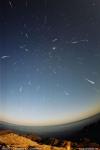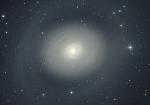
|
Astronomy Picture Of the Day (APOD)
 Surveyor Hops
Surveyor Hops
30.11.2002
This panorama of the cratered lunar surface was constructed from images returned by the US Surveyor 6 lander. Surveyor 6 was not the first spacecraft to accomplish a soft landing on the Moon ... but it was the first to land and then lift off again!
 Open Star Clusters M35 and NGC 2158
Open Star Clusters M35 and NGC 2158
29.11.2002
Open clusters of stars can be near or far, young or old, and diffuse or compact. Open clusters may contain from 100 to 10,000 stars, all of which formed at nearly the same time. Bright blue stars frequently distinguish younger open clusters.
 The Supermassive Black Holes of NGC 6240
The Supermassive Black Holes of NGC 6240
28.11.2002
The Hubble optical image on the left shows NGC 6240 in the throes of a titanic galaxy - galaxy collision 400 million light-years away. As the cosmic catastrophe plays out, the merging galaxies spew forth distorted tidal tails of stars, gas, and dust and undergo frantic bursts of star formation.
 Leonids and Leica
Leonids and Leica
27.11.2002
This lovely view from northern Spain, at Cape Creus on the easternmost point of the Iberian peninsula, looks out across the Mediteranean and up into the stream of the 2002 Leonid meteor shower.
 Name This Martian Robot
Name This Martian Robot
26.11.2002
NASA will launch two robots to Mars next year and you can help name them. The Mars Exploration Rovers are scheduled for launch on or near this coming June, when Mars and Earth are relatively close in their orbits.
 The Earths Magnetic Field
The Earths Magnetic Field
25.11.2002
Why does the Earth have a magnetic field? The electrical conductivity of the molten plasma of the Earth's core should be able to damp the current magnetic field in only thousands of years. Yet our five billion year old Earth clearly causes magnets to point to (defined) north.
 Hubble Floats Free
Hubble Floats Free
24.11.2002
Why put observatories in space? Most telescopes are on the ground. On the ground, you can deploy a heavier telescope and fix it more easily. The trouble is that Earth-bound telescopes must look through the Earth's atmosphere.
 Mare Orientale
Mare Orientale
23.11.2002
Like a target ring bull's-eye, the Mare Orientale is one of the most striking large scale lunar features. Located on the Moon's extreme western edge, this impact basin is unfortunately difficult to see from an earthbound perspective.
 Full Moon, Lake, and Leonids Indeed
Full Moon, Lake, and Leonids Indeed
22.11.2002
Full of itself moon - EVERYONE SHOULD LOOK AT ME. What's 33 years? And for those who need a story ... photographer Blake Suddeth took over a hundred digital pictures early Tuesday morning in order...
 Starburst Galaxy M94
Starburst Galaxy M94
21.11.2002
What could cause the center of M94 to be so bright? Spiral galaxy M94 has a ring of newly formed stars surrounding its nucleus, giving it not only an unusual appearance but also a strong interior glow.
|
January February March April May June July August September October November December |
|||||||||||||||||||||||||||||||||||||||||||||||||